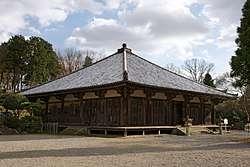Jōdo-ji (Ono)
| Gokurakusan Jōdo-ji | |
|---|---|
 Jōdodō | |
| Basic information | |
| Location | 2094, Kiyotani-cho, Ono, Hyogo 675-1317 |
| Affiliation | Shingon |
| Country | Japan |
| Architectural description | |
| Founder | Chōgen |
| Completed | 1190 - 1198 |

Yakushido (Main hall)
The Gokurakusan Jōdo-ji (極楽山浄土寺) is a temple of the Shingon sect in Ono, Hyōgo, Japan. It was established by Chōgen in 1190 - 1198.
Jōdo-ji's Jōdodō completed in 1194 is a National Treasure of Japan. The architecture is in the Daibutsu style that combines Japanese and Chinese elements.
List of buildings
- Jōdodō - built in 1194. National Treasure of Japan.[1]
- Yakushiō (Main hall) - Important Cultural Property of Japan.[2] It was rebuilt in 1517.
- Hachiman-jinja honden - Important Cultural Property of Japan.
- Hachiman-jinja haiden - Important Cultural Property of Japan.
- Kaizanō - rebuilt in 1520.
- Bell tower - rebuilt in 1632.
- Fudodō
- Monjudō
- Kyozō
List of sculptures
- Amitabha Triad - National Treasure of Japan.[3] Kaikei's most important work. It is a work in 1195-1197. Height: 24.6 ft
- Amitabha - Important Cultural Property of Japan. Kaikei's work. It is a work in 1201. Loaned to Nara National Museum.
- Chōgen- Important Cultural Property of Japan. (1234)
- Buddhist saint's mask, 25 pieces - Important Cultural Property of Japan. It is a work of Kaikei's school.
List of craftwork
List of paintings
See also
Gallery
 Bell tower
Bell tower Kaizandō
Kaizandō Fudoō
Fudoō Hachiman-jinja honden and haiden
Hachiman-jinja honden and haiden
Citations
External links
| Wikimedia Commons has media related to Jōdo-ji (Ono). |
- 神戸大学附属図書館「浄土寺縁起」 (Japanese)
Coordinates: 34°51′51″N 134°57′40″E / 34.8642°N 134.961°E
This article is issued from
Wikipedia.
The text is licensed under Creative Commons - Attribution - Sharealike.
Additional terms may apply for the media files.